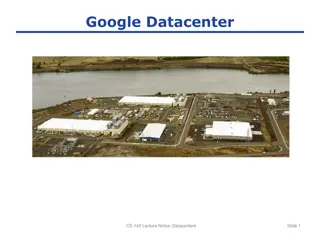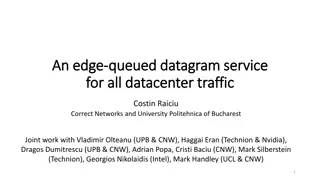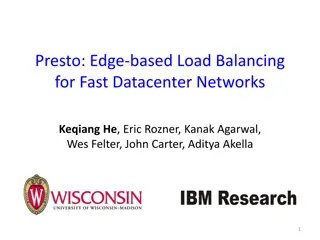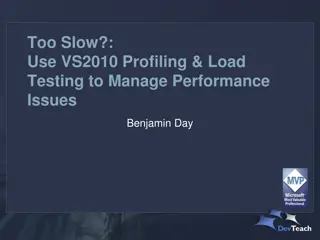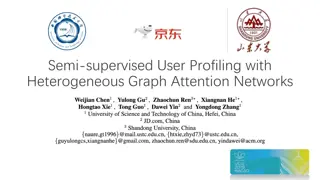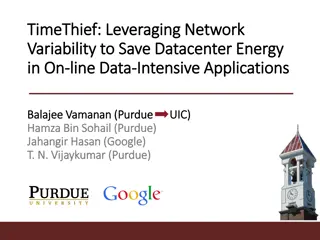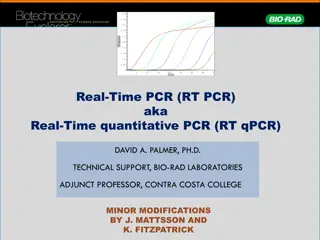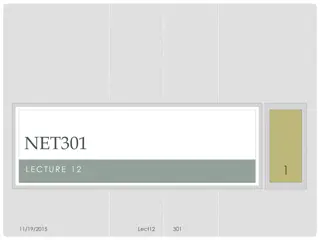Profiling Network Performance in Multi-tier Datacenter Applications
Challenges in diagnosing large, complex applications within data centers are addressed in this collaborative work. The need for scalable tools like the SNAP profiler is highlighted to efficiently monitor and improve network performance.
Download Presentation

Please find below an Image/Link to download the presentation.
The content on the website is provided AS IS for your information and personal use only. It may not be sold, licensed, or shared on other websites without obtaining consent from the author. Download presentation by click this link. If you encounter any issues during the download, it is possible that the publisher has removed the file from their server.
E N D
Presentation Transcript
Profiling Network Performance in Multi-tier Datacenter Applications Minlan Yu Scalable Net-App Profiler Princeton University Joint work with Albert Greenberg, Dave Maltz, Jennifer Rexford, Lihua Yuan, Srikanth Kandula, Changhoon Kim 1
Applications inside Data Centers . . . . Front end Server Aggregator Workers 2
Challenges of Datacenter Diagnosis Large complex applications Hundreds of application components Tens of thousands of servers New performance problems Update code to add features or fix bugs Change components while app is still in operation Old performance problems (Human factors) Developers may not understand network well Nagle s algorithm, delayed ACK, etc. 3
Diagnosis in Todays Data Center Packet trace: Filter out trace for long delay req. Too expensive App logs: #Reqs/sec Response time 1% req. >200ms delay Application-specific Host App Packet sniffer OS SNAP: Diagnose net-app interactions Switch logs: #bytes/pkts per minute Too coarse-grained Generic, fine-grained, and lightweight 4
SNAP: A Scalable Net-App Profiler that runs everywhere, all the time 5
SNAP Architecture At each host for every connection Collect data 6
Collect Data in TCP Stack TCP understands net-app interactions Flow control: How much data apps want to read/write Congestion control: Network delay and congestion Collect TCP-level statistics Defined by RFC 4898 Already exists in today s Linux and Windows OSes 7
TCP-level Statistics Cumulative counters Packet loss: #FastRetrans, #Timeout RTT estimation: #SampleRTT, #SumRTT Receiver: RwinLimitTime Calculate the difference between two polls Instantaneous snapshots #Bytes in the send buffer Congestion window size, receiver window size Representative snapshots based on Poisson sampling 8
SNAP Architecture At each host for every connection Collect data Performance Classifier 9
Life of Data Transfer Sender App Application generates the data Send Buffer Copy data to send buffer TCP sends data to the network Network Receiver receives the data and ACK Receiver 10
Taxonomy of Network Performance Sender App No network problem Send Buffer Send buffer not large enough Fast retransmission Timeout Network Not reading fast enough (CPU, disk, etc.) Not ACKing fast enough (Delayed ACK) Receiver 11
Identifying Performance Problems Not any other problems Sender App #bytes in send buffer Send Buffer Sampling #Fast retransmission #Timeout Network Direct measure RwinLimitTime Delayed ACK diff(SumRTT) > diff(SampleRTT)*MaxQueuingDelay Inference Receiver 12
SNAP Architecture Management System Topology, routing Conn proc/app At each host for every connection Cross- connection correlation Collect data Performance Classifier Offending app, host, link, or switch 13
Pinpoint Problems via Correlation Correlation over shared switch/link/host Packet loss for all the connections going through one switch/host Pinpoint the problematic switch 14
Pinpoint Problems via Correlation Correlation over application Same application has problem on all machines Report aggregated application behavior 15
SNAP Architecture Offline, cross-conn diagnosis Online, lightweight processing & diagnosis Management System Topology, routing Conn proc/app At each host for every connection Cross- connection correlation Collect data Performance Classifier Offending app, host, link, or switch 16
Reducing SNAP Overhead SNAP overhead Data volume: 120 Bytes per connection per poll CPU overhead: 5% for polling 1K connections with 500 ms interval Increases with #connections and polling freq. Solution: Adaptive tuning of polling frequency Reduce polling frequency to stay within a target CPU Devote more polling to more problematic connections 17
Key Diagnosis Steps Identify performance problems Correlate across connections Identify applications with severe problems Expose simple, useful information to developers Filter important statistics and classification results Identify root cause and propose solutions Work with operators and developers Tune TCP stack or change application code 19
SNAP Deployment Deployed in a production data center 8K machines, 700 applications Ran SNAP for a week, collected terabytes of data Diagnosis results Identified 15 major performance problems 21% applications have network performance problems 20
Characterizing Perf. Limitations #Apps that are limited for > 50% of the time Send Buffer Send buffer not large enough 1 App Fast retransmission Timeout Network 6 Apps Not reading fast enough (CPU, disk, etc.) Not ACKing fast enough (Delayed ACK) 8 Apps 144 Apps Receiver 21
Three Example Problems Delayed ACK affects delay sensitive apps Congestion window allows sudden burst Significant timeouts for low-rate flows 22
Problem 1: Delayed ACK Delayed ACK affected many delay sensitive apps even #pkts per record 1,000 records/sec odd #pkts per record 5 records/sec Delayed ACK was used to reduce bandwidth usage and server interrupts A B ACK every other packet . Proposed solutions: Delayed ACK should be disabled in data centers 200 ms 23
Send Buffer and Delayed ACK SNAP diagnosis: Delayed ACK and zero-copy send Application buffer Application With Socket Send Buffer 1. Send complete Socket send buffer Receiver Network Stack 2. ACK Application buffer Application Zero-copy send Receiver 2. Send complete Network Stack 1. ACK 24
Problem 2: Congestion Window Allows Sudden Bursts Increase congestion window to reduce delay To send 64 KB data with 1 RTT Developers intentionally keep congestion window large Disable slow start restart in TCP Drops after an idle time Window t 25
Slow Start Restart SNAP diagnosis Significant packet loss Congestion window is too large after an idle period Proposed solutions Change apps to send less data during congestion New transport protocols that consider both congestion and delay 26
Problem 3: Timeouts for Low-rate Flows SNAP diagnosis More fast retrans. for high-rate flows (1-10MB/s) More timeouts with low-rate flows (10-100KB/s) Proposed solutions Reduce timeout time in TCP stack New ways to handle packet loss for small flows 27
Conclusion A simple, efficient way to profile data centers Passively measure real-time network stack information Systematically identify problematic stages Correlate problems across connections Deploying SNAP in production data center Diagnose net-app interactions A quick way to identify them when problems happen Future work Extend SNAP to diagnose wide-area transfers 28
Thanks! 29


